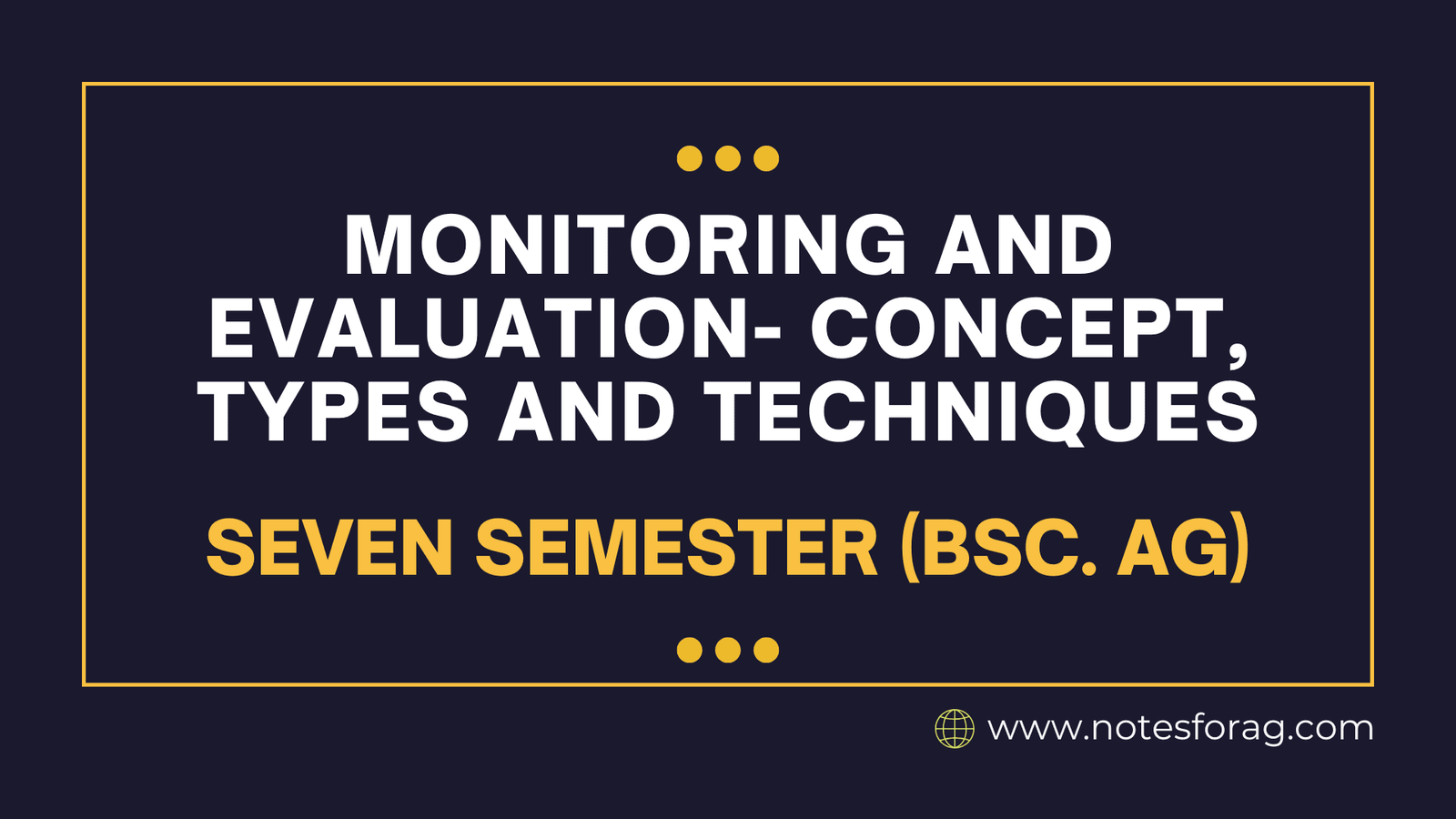Monitoring and Evaluation (M&E) are essential processes in project management that help ensure projects are progressing as planned and achieving their desired outcomes. These processes provide valuable insights to help decision-makers improve the project’s effectiveness. In the agricultural sector, where challenges such as limited resources, unpredictable weather, and market conditions can impact success, M&E is critical for ensuring that the project stays on track and delivers sustainable results.

Table of Contents
Concept of Monitoring and Evaluation

Monitoring refers to the ongoing observation and tracking of a project’s activities, outputs, and resources. It helps ensure that everything is going according to plan by continuously checking whether tasks are being completed and goals are being met. Monitoring allows project managers to identify and correct problems as they arise, ensuring the project stays on course.
Evaluation is a more in-depth assessment that occurs at specific points in the project—either during or at the end. It looks at the overall effectiveness of the project, its efficiency, and its broader impacts. While monitoring focuses on daily progress, evaluation helps determine whether the project achieved its objectives and examines lessons that can be applied to future projects.
Together, M&E provides a comprehensive view of how well a project is performing, helping improve outcomes and guide better decision-making.
Importance of Monitoring and Evaluation
Accountability: M&E holds project teams accountable for the efficient use of resources and the results achieved.
Continuous Improvement: By providing feedback during the project, monitoring allows real-time adjustments to improve performance.
Informed Decision-Making: Evaluation results help stakeholders decide if the project should continue, expand, or be adjusted.
Learning and Adaptation: The insights gained from evaluations help inform future projects by highlighting successes and learning from mistakes.
Types of Monitoring
There are several different types of monitoring, each serving a specific role depending on the project phase and goals:
Process Monitoring
This type tracks whether the project activities are being implemented as planned. In agriculture, this could mean checking if inputs like seeds and fertilizer are being delivered on time and correctly applied.
Results Monitoring
This focuses on whether the project’s activities are producing the expected results, such as increased crop production or improved incomes for farmers.
Compliance Monitoring
Ensures that the project adheres to legal, ethical, and regulatory standards, such as environmental regulations or funding requirements.
Financial Monitoring
Keeps track of the project’s budget and expenses, ensuring that resources are being used efficiently without overspending.
Beneficiary Monitoring
This type focuses on the impact of the project on its intended beneficiaries, evaluating whether the project is meeting their needs and improving their lives.
Types of Evaluation
Evaluations can be conducted at different stages of a project and serve different purposes:
Formative Evaluation
Done in the early stages of a project, formative evaluation helps improve the project design by identifying potential issues before they become problems.
Summative Evaluation
Conducted at the end of a project, summative evaluation assesses whether the project met its goals and what impacts it had on the community or environment.
Process Evaluation
This looks at how well the project was implemented, assessing whether the activities were carried out as planned and identifying any challenges in execution.
Impact Evaluation
Focuses on the long-term effects of the project. In agriculture, this might include the project’s impact on food security, income generation, or environmental sustainability.
Midterm Evaluation
Carried out halfway through the project, this evaluation provides an opportunity to assess progress and make adjustments if necessary.
Techniques of Monitoring and Evaluation
Various techniques are employed in M&E to gather data and assess performance:
Surveys and Questionnaires: These are commonly used to gather information from beneficiaries and stakeholders about their experiences, satisfaction, and the outcomes of the project.
Interviews: Interviews with project participants, staff, or community members provide detailed insights into how the project is progressing and any challenges being faced.
Field Observations: This involves visiting project sites to observe activities and verify progress firsthand. For example, in agricultural projects, it might involve inspecting crop conditions or checking the proper use of equipment.
Focus Group Discussions: Bringing together groups of beneficiaries or stakeholders to discuss their experiences with the project, focus groups provide qualitative data and deeper insights into the project’s impacts.
Data Collection Tools: In modern M&E, tools like mobile apps, drones, and GPS devices are used to collect real-time data on various project aspects, such as crop health or soil conditions.
Performance Indicators: Pre-established metrics, or key performance indicators (KPIs), help measure the project’s success. In agriculture, KPIs might include crop yields, income changes, or the number of beneficiaries served.
Conclusion
Monitoring and Evaluation are vital processes in agricultural project management, ensuring that projects are not only progressing as planned but also delivering meaningful outcomes. Monitoring helps track day-to-day activities, while evaluation takes a broader look at overall success and lessons learned. By using a variety of techniques, including surveys, interviews, and modern data collection tools, M&E provides valuable insights for decision-making, accountability, and continuous improvement. This process helps ensure that agricultural projects are efficient, effective, and capable of delivering long-term benefits for farmers, communities, and the environment.
Frequently Asked Questions (FAQ)
What is monitoring in project management?
Monitoring is the continuous tracking of a project’s activities, resources, and progress to ensure everything is going as planned. It helps identify issues early on, so they can be addressed quickly, allowing the project to stay on track.
Why is monitoring and evaluation important in agricultural projects?
Monitoring and evaluation is crucial in agricultural projects because it ensures that resources like labor, capital, and inputs (seeds, fertilizers) are used effectively, risks are minimized, and the project achieves its goals, such as improving crop yields or livelihoods.
Related Articles

